When people mention “Sky Blue” they are usually referring to a generic light blue color, instead of the exact color of a blue sky. In this article, I demonstrate how to mix a variety of colors that could be used as Sky Blue. I also demonstrate how to match the exact color of the sky from direct observation.
Sky Blue is quite simple to mix. All of the colors that I mixed for this article follow the same principles. Start with a generous amount of white and add blue to it. Many blues will work, but Ultramarine Blue is a good color to begin with. To make it a reddish blue, add a small touch of magenta. To create a duller blue, add a touch of yellow along with the magenta. These general principles will work whether you’re mixing a generic Sky Blue or the exact color of the sky.
If you want to learn how to mix colors, you may be interested in my color mixing course. In the first few demonstrations I use only use 3 colors plus white to match colors. Using a smaller palette of colors makes the decision process easier than having to choose from a palette of 15 or more colors.
To learn more about my course visit the link below.
In this course I teach the color mixing techniques that I use in my social media color matching videos. It's for beginners and advanced painters. It includes 60 minutes of video.
All links to Blick Art Materials are affiliate links. This means if you click on it and make a purchase I earn a commission at no cost to you.
Which Blue Should I Use to Mix Sky Blue?
There are many shades of Blue available to artists. There’s Ultramarine, Cobalt, Cerulean, Phthalo, just to name a few. Many blues will can be used to mix Sky Blue. In the examples that follow, I use three different blues to mix very similar colors. If you have an understanding of color theory, you can often mix the same color from different pigments.
Ultramarine Blue works well as a starting point for the exact shade of the darkest part of a blue sky. Cobalt Blue and white makes a nice light blue that passes for the concept of sky blue.
Memory Colors
Sky blue is a “memory color,” which is more of a general concept than a precise color. Everybody has a concept in their mind about the colors of familiar objects. For example, there’s candy apple red, grass green, and robin egg blue. All of us have used descriptions like these to quickly convey a basic color concept in a conversation.
Even if we’re trying to match the color of the sky from direct observation, there are a lot of variables that will affect it–weather, the time of day, and which part of the sky you’re looking at. So that’s another reason why there’s so many shades of Blue that artists use in landscape paintings. In addition to these variables, artists invent their own creative color schemes for their paintings.
About the Step by Step Photos
In the first three demonstrations I use three different Blues to mix colors the memory color version of Sky Blue. I’m mixing these colors from my imagination, and not from direct observation.
If you’re new to color mixing, I don’t want you to give you the impression that I mix the color with some sort of exact recipe and get it right on the first try. Mixing colors requires a lot of small adjustments. For example, you’ll see that I sometimes add too much of a color and then have to compensate for it. This is a normal part of the color mixing process.
The photos show a paint brush at the bottom with a small daub of color on it. This is what I’m going to add to the existing color on my palette. The swatch of color above and to the right of the paint brush is the result. For example, in the first photo there’s white on the palette and a small amount of Phthalo Blue on the tip of the brush. The color swatch to the top right is the result-it’s light blue.
Mixing Sky Blue Using Phthalo Blue
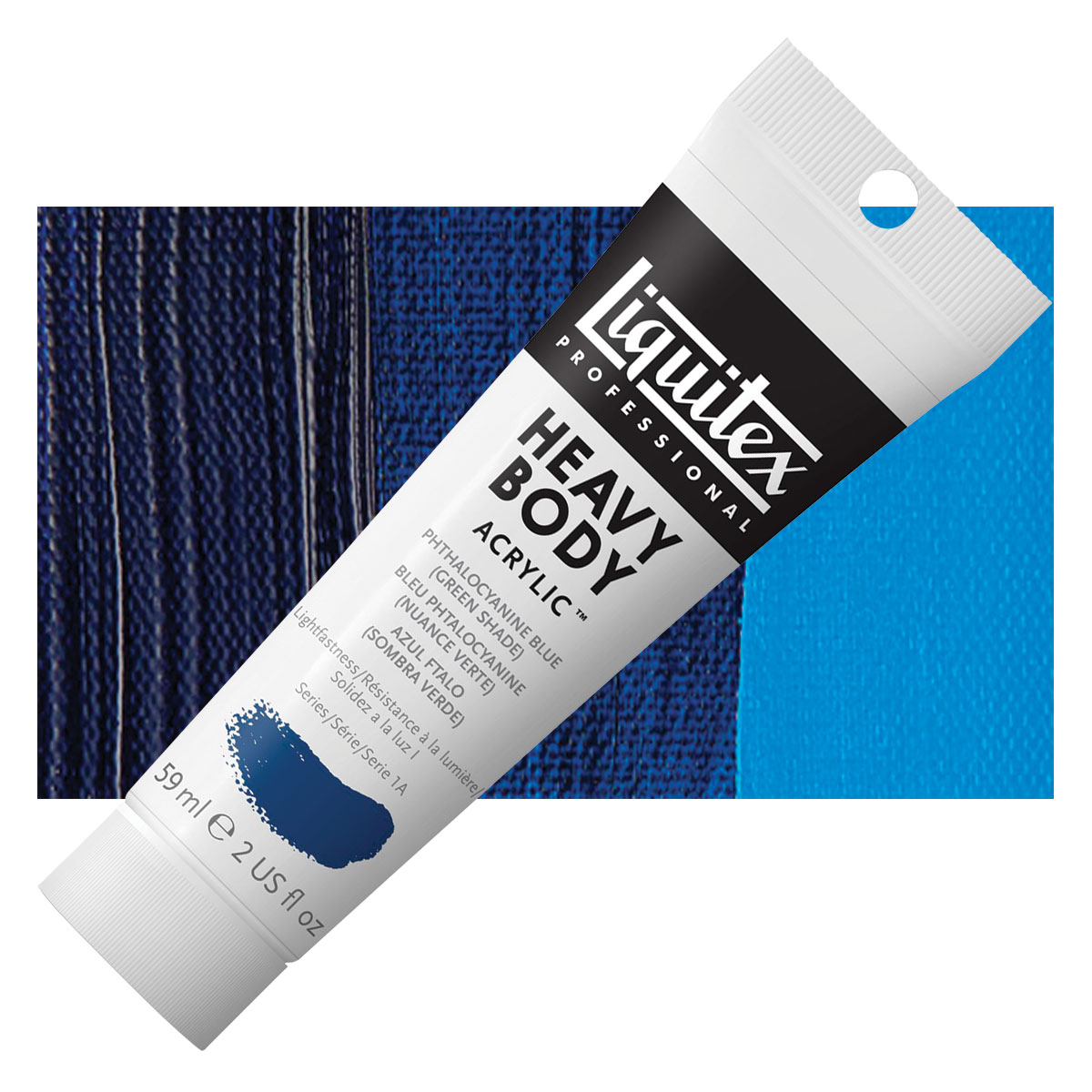
Liquitex Professional Heavy Body Acrylics and Sets
from: Blick Art Materials
Phthalo Blue is available in two shades; green shade, and red shade. The green shade is the more common version and that’s what I use here. All of the color swatches in the examples below could be interpreted as Sky Blue. I mixed a variety of colors to demonstrate how to make it a reddish blue, more neutral, or a light blue.
Following the strategy that I described in the introduction, I start by mixing a small amount of Phthalo Blue into a larger daub of Titanium White. The tinting strength of Phthalo Blue is tremendous, a small daub of it can tint a larger amount of white. The result is the first light blue patch along the top.
Use Magenta to Counteract the Green
Phthalo Blue is biased towards green, so I like to add a small amount of Quinacridone Magenta to neutralize the green somewhat. The amount of magenta is shown at the bottom left of the paintbrush in the second photo along the bottom–it’s not much. If you don’t have magenta, Alizarin Crimson would also work. The result is the second color swatch along the top.

The color of the sky is lighter near the horizon. It’s also more neutral and not as saturated as you think. To neutralize the blue and make it less intense, add a very small amount of Hansa Yellow Medium. The amount of yellow can be seen on the corner of the paint brush in the third photo on the bottom. You may think that adding yellow would make it green, but the small amount of magenta will help prevent it from turning too green.
The third color swatch along the top is the neutralized blue. To create lighter variations of the neutral sky blue, add Titanium White. The result is the fourth color swatch along the top row of the photo. The fifth color swatch is an even lighter version.
Mixing Sky Blue Using Ultramarine Blue
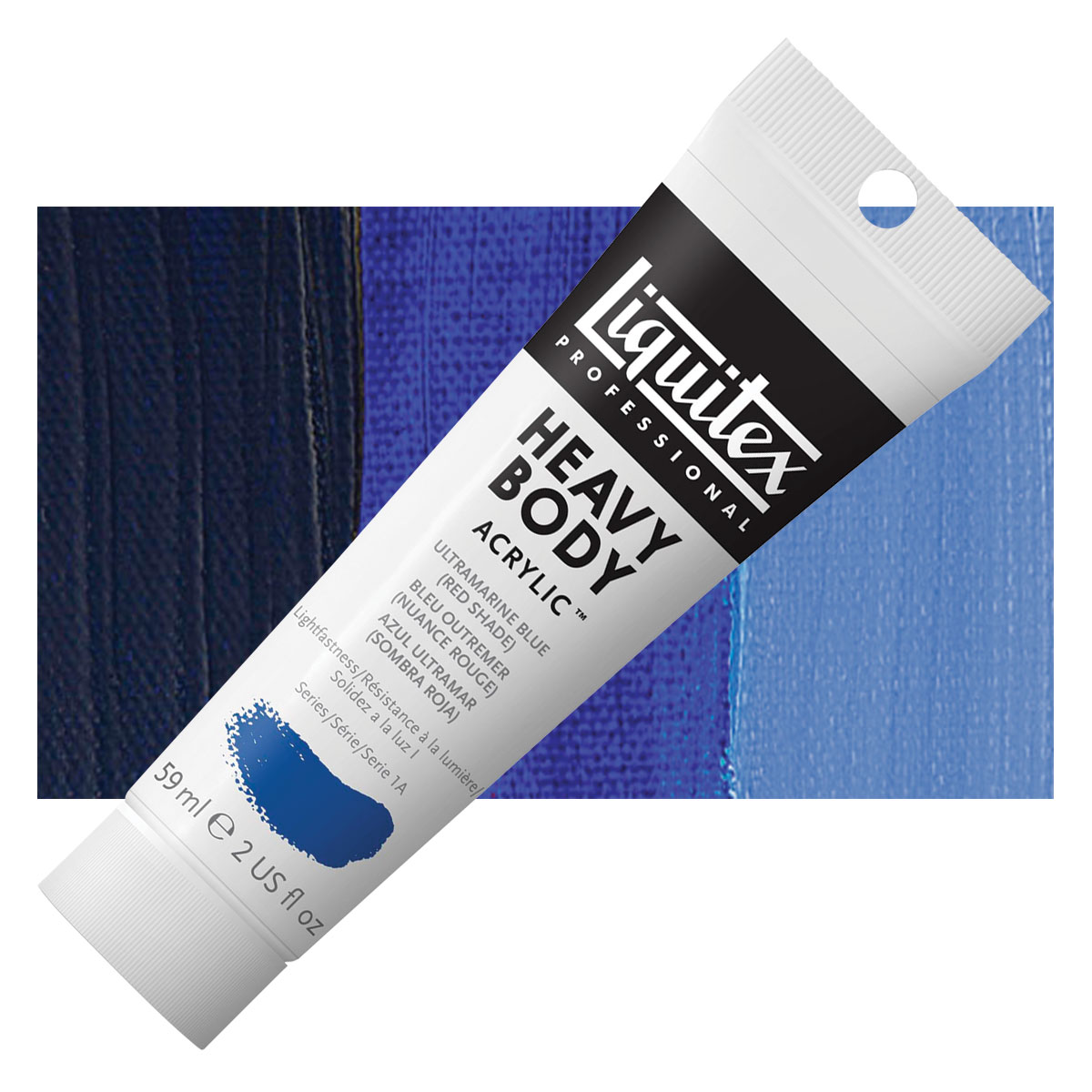
Liquitex Professional Heavy Body Acrylics and Sets
from: Blick Art Materials
I follow the same strategy for the Ultramarine Blue. I start by mixing Ultramarine Blue with Titanium White. This blue doesn’t have the same tinting strength as Phthalo Blue, so I use more of it.
Next, I add Quinacridone Magenta to make it more of a reddish blue. The result is a little too purple in my opinion. This is a good example of the small adjustments that are made when mixing colors. To make it less purple, I add more a large daub of Ultramarine Blue. The result is the third color swatch along the top. This is close to the color of the darkest part of a blue sky.

I add white to lighten it. The result is the fourth color swatch along the top. A small touch of Hansa Yellow Medium dulls it down slightly. The result is the fifth color swatch along the top. And for the last color swatch, I add more Titanium White to lighten it.
Mixing Sky Blue with Cobalt Blue
Cobalt Blue produces a decent Sky Blue by just adding white to it. In the first three steps are variations of just adding white in various increments. Then I added Quinacridone Magenta, but it was too much. I neutralized it with a touch of Hansa Yellow Medium. The result is the fifth color swatch along the top. It’s almost gray! To get back on track, I added more Cobalt Blue and Titanium White. The last photo at the bottom shows the amount of Blue I added on the paint brush, and the additional white is on the palette underneath it.

Summary of the Results
Almost all of the color swatches that I made with these three blues could be used as a Sky Blue color. The objective was to mix a variety of blues that could about used for Sky Blue. I mixed blues that were dark, light, and neutral.
The basic steps are to mix blue with white. If it’s too green then use magenta to counteract it. A combination of yellow and magenta can be used to neutralize the blue and make it less intense and more gray.
Some of the photos are the in-between stages of trying to compensate for adding too much of a color. This is how color mixing is done. It’s not like the paint department at the hardware store where there’s an exact formula that you follow. As you gain experience with mixing colors, you will develop a sense of what you need to add to match a color.
Matching the Exact Color of a Blue Sky
Now that I’ve mixed a series of the Sky Blue from my imagination, I thought I would match the exact color of the darkest part of a blue sky. I use the same strategy of adding magenta, yellow, and white to alter the blue.
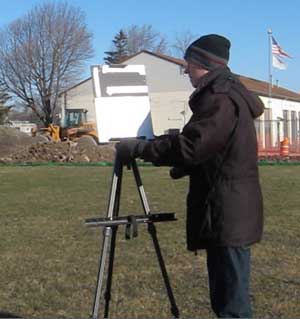
If you want to try this yourself, I suggest doing it early in the morning when the sun is closest to the horizon. Set up your easel so you’re facing away from the sun. This will help you to keep the sun out of your eyes. Protect your eyes– never look directly at the sun!
The Challenge of Matching Colors Outdoors
Before I demonstrate matching the color of blue sky, it’s important to recognize the complexities involved in matching colors outdoors.
Anybody who has ever painted outside understands the challenge of matching colors outdoors. The assumption is you can mix a color and hold the palette knife up to the subject to determine if it’s a match. This seems logical but it would only work if the subject is in the same lighting as your palette.
For example, if a red barn is in direct sunlight and you’re standing in the shade, then the colors on your palette will never appear as bright as the sunlit barn. Perhaps you could resolve this by mixing your colors in direct sunlight. The only problem with this, aside from sunburn, is that paintings are typically viewed indoors where the lighting is dim. If you paint in direct sunlight and bring the paintings indoors, the colors are likely going to look darker than what you intended.
When you compare the color on your palette knife to the landscape, it changes based upon how you hold it. If you tilt the palette knife slightly, it changes the way the light reflects off of it. If it receives more light, then the color will look brighter, and darker if it receives less light.
The above is just a long way of saying that mixing colors for a painting requires subjective decisions and experience. In this example my goal was to match the color of the blue sky as close as possible. If I were working on a painting I might use the color that I feel would work best with the rest of the painting.
Mixing the Color of the Darkest Part of a Blue Sky
The darkest part of a clear blue sky on a clear afternoon is easily matched by mixing Ultramarine Blue and Titanium White. Small amounts of yellow and magenta are needed to dull the Ultramarine Blue. I used Diarylide Yellow and Quinacridone Magenta for this purpose. Alizarin Crimson would work in place of the magenta. Other yellows would work in place of Diarylide Yellow.
Ultramarine Blue or Phthalo Blue?
I start by determining which Blue is closest to the darkest part of the sky overhead. I normally have Ultramarine Blue and Phthalo Blue on my palette. Ultramarine Blue is biased towards red and Phthalo Blue is biased towards green. Ultramarine is a closer match, so that’s the color I will begin with.

Add White to Ultramarine Blue
Now that I have chosen a blue to start with, the next step is to decide what I need to add to get it closer to the color of the sky. Full strength Ultramarine Blue is obviously too dark, so use Titanium White to lighten it.
The best way to determine if it matches is to hold the palette knife up to the sky and compare the color directly to the color of the sky. It would be unusual to get it right on the first try. It’s either going to be too dark or too light. As I mentioned above, tilting the palette knife as you compare it to the sky will make the color appear darker or lighter. You’ll want to try and compare it to the sky at the same angle each time.
If it’s too light, then add more Ultramarine Blue. If it’s too dark then add some more Titanium White. Repeat this process until you have a Blue that’s close to the value of the sky. Value is the lightness or darkness of a color.
There’s Yellow in a Blue Sky!
Once the value of the mixture is close to the value of the sky then it’s a matter of fine tuning the color. Value is the lightness or darkness of a color.
“What does this need?” That’s what I ask myself when I compare a color mix to the target color. The Ultramarine Blue is actually too saturated compared to the sky. What could I use to dull it down? This sounds weird but I could tell that there’s yellow in a Blue sky. It’s a small amount, but it’s there. As you get closer to matching a color, the fine tuning becomes more minute. It may be difficult to determine what you need to add to make it a closer match.
There are many times when you’re matching colors or working on a drawing and you’ll notice something that runs contrary to your beliefs. In this case it’s the belief that Sky Blue is a mixture of blue and white. Yellow doesn’t even enter my mind when I think about a blue sky.
Whenever you encounter this discrepancy between what you believe and what you observe, go with the observation. This is the key to accurate drawing, painting, and color matching. You’re looking for those key observations that give you the information that you’re missing. If I were to ignore the yellow that I perceived in the sky, my blue would look close, but it would have been off.
Use Yellow and Magenta to Neutralize the Blue
I used Diarylide Yellow but you could also try Hansa Yellow Medium or Cadmium Yellow Light. I add a very small amount of Quinacridone Magenta to counteract the yellow to prevent the blue from turning green, It helps to decrease the saturation of the blue. You could also use a reddish orange to neutralize the blue.
Once I have a close match, I’ll add a very tiny amount of Titanium White. Acrylics dry darker, and the white will help to compensate for that. It may look too light but it should match as it dries. I use my palette knife to spread it onto a strip of paper made for acrylics.
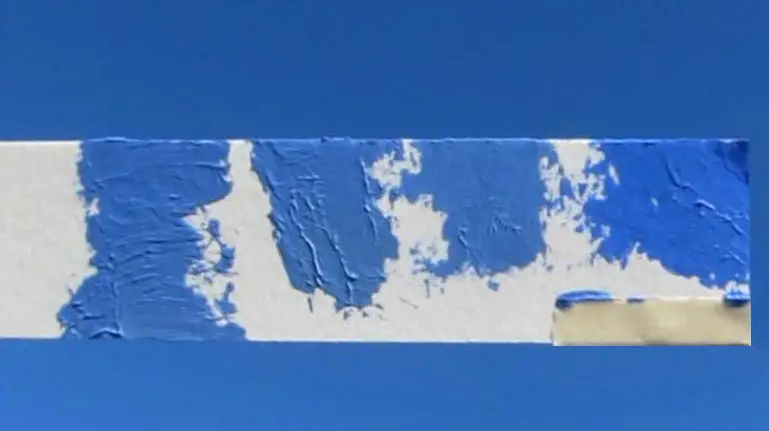
The blue on the left is the closest match to the darkest part of the sky. The color of the darkest part of a blue sky may appear darker than you think it should be. This is also not the typical color that’s used for the sky in most paintings. That’s because landscape paintings contain the portion of the sky that is closest to the horizon, which is lighter in color.
Matching the Color of the Sky near the Horizon
The light blue near the horizon can be mixed using the same techniques I used to create sky blues from memory. Below is a close approximation of the light blue near the horizon line. Yellow and magenta were used to neutralize the Ultramarine Blue and then I added Titanium White to lighten it. The color near the horizon is less red than Ultramarine so add a small touch of Phthalo Blue.

Conclusion
Matching colors from direct observation will improve your color mixing skills. Once you have mastered the basic skills of color mixing, you can match any color you see or imagine. Have fun with your painting!


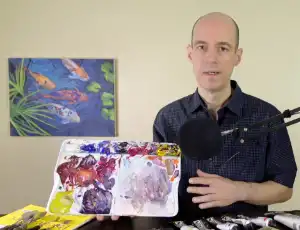
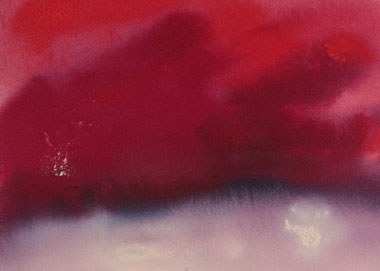


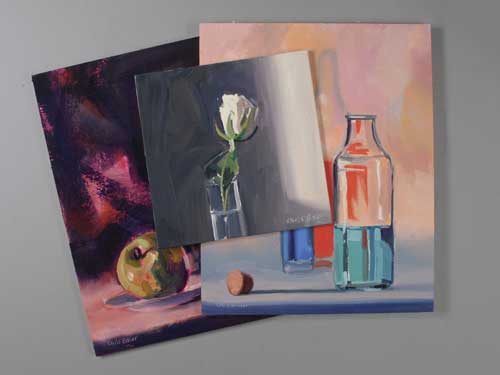
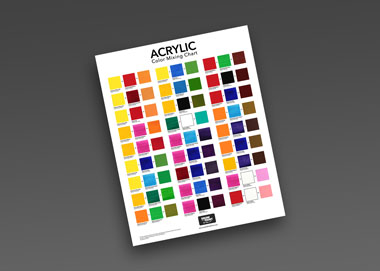
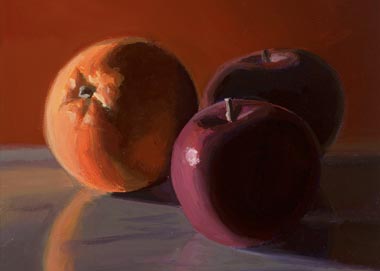
Sensational explanation. So simple and easy to understand. Many thanks for the help. Cheers. Steve
Thanks Steve, I’m glad you found it useful!
Thank you, I can’t wait to try this! As Steve said, your explanation is wonderful and easy to understand. I just painted over my latest attempt because I started with the sky and messed it up so badly. Maybe there’s hope yet 🙂 I’m a new painter and have much to learn.
Thanks Kathy, I hope your next attempt comes out better!